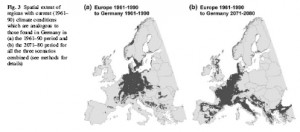- Internets all aglow today, so hang on to your hats, here we go. Drought forcing Kenyans out of maize, towards indigenous crops, wheat and rice. Wait, what?
- Making money from tree seedlings in Uganda. Including indigenous stuff. Damn you, allAfrica, why are you so good?
- ‘Turkey’ Hard Red Winter Wheat, Lake Michigan Whitefish, the Hauer Pippin Apple, and the St. Croix sheep, among others, added to Ark of Taste. Ok, I’m gonna have to see some explanation for that wheat one.
- Singing the praises of pulses. Even Virgil gets a namecheck.
- Tall Fescue for the Twenty-first Century? Seriously, who writes these titles?
- nth study on bees announced. And n+1st reports. And n+2nd called for. CABI does a bit of a roundup. Bless you.
- Declaration calls for “…the creation of democratic spaces for intercultural dialogue and the strengthening of interdependent networks of food producers and other citizens.” Interesting.
- Small scale farmers produce most of what Brazilians eat. And no doubt manage most of the country’s agrobiodiversity. And Cuba?
- Chinese aquaculture goes green? Riiiiight.
- “Earlier this year, farmers from the north who had benefitted from previous improved seedling activities by the International Institute of Tropical Agriculture (IITA) demanded for more improved seed varieties from scientists.” Oh come on, gimme a clue. What crop? Improved how?
- Medieval Bruges palace cesspit reveals dukes ate Mediterranean honey. Sybarites even then, the Belgians.
- Scientific American says IFPRI says “traditional seed varieties and livestock breeds that might provide a genetic resource to adapt to climate change are being lost.”
- Late Blight 101.
Nibbles: WFP and Millennium Villages, Agroecotourism squared, Mango, Wild pollinators, CGIAR change process, Grape breeding, Landraces and climate change, Mau Forest, Eels
- “…WFP’s partnership with the Millennium Villages Project would deploy the full range of the Programme’s tools and help utilize the Millennium Villages as a platform for best practices.” Good. But let’s just hope the villagers’ own best tool — agrobiodiversity — doesn’t get left behind.
- More on the Cotacachi agroecotourism project in Ecuador.
- Heritage tourism in the Virgin Islands targets old sugar cane mill.
- The “mango villages” of India.
- Pollination needs to go wild.
- Ok, so the CGIAR is going to re-organize itself into mega-programmes (look at the PDF at the bottom of the page), one of which is on “Crop germplasm conservation, enhancement and use.” Big deal? I wish I knew.
- Pssst, wanna discuss grape breeding?
- More from IIED on landraces and climate change.
- Deforestation, drought and politics in Kenya.
- Tracking eel migrations.
Nibbles: Non-wood forest products, Landraces and climate change, Brewing, IRRI, Agroforestry, Borlaug, Mutant
- New NWFP Digest is out. Bamboo, bamboo and more bamboo. You all have subscribed, right?
- Your indigenous seeds will set you free. Not if you don’t have a breeding programme and decent seed companies they wont. Or not only.
- College students to evaluate hop varieties. What could possibly go wrong?
- “The IRRI is not involved in any projects on land acquisition for rice production, nor do we provide advice on land acquisition.”
- Agroforestry professor interviewed by Mongabay.
- Edwin Price vs Vandana Shiva on Borlaug on Oz radio. Let the games begin.
- Cool chimeric apple.
Nibbles: Légumes oubliés, Mazes, Poultry, Business, Roquefort, Herb, Evolution, Benin, Egyptian pigs, New York food, Cabbage pest control, Cider making
- Francophones! Watch this. Report back.
- Geographers! Play with this. Global collection of crop mazes.
- Chicken fanciers and development officers! Read this (pdf). Increase assets, income and nutrition.
- Agro-business! Respond to this. Please.
- Cheese lovers! Watch this. Salivate.
- Chemists! Find out why Teucrium tastes like apple. Or is it that apple tastes like Teucrium?
- Females! Why are you horny?
- Farmers! Get information to adapt to climate change.
- Egyptian pig cull! Bad. No, good. No, bad…
- Brooklynites! Wallow in ethnic cuisine.
- Africans! Why bother with cabbage when you have so many much more interesting leafy greens?
- Scrumpers! Get thee to Eden!
Istanbul on the Rhine
![]() Good news for sun-loving Germans. By 2071-2080 parts of their country are going to have the climate that parts of Greece have now. That’s according to a paper in Plant Ecology which ran a bunch of climate change models for Europe. 1 Have a look at the money map.
Good news for sun-loving Germans. By 2071-2080 parts of their country are going to have the climate that parts of Greece have now. That’s according to a paper in Plant Ecology which ran a bunch of climate change models for Europe. 1 Have a look at the money map.
On the left are today’s Germany-like climates in Europe. On the right is where Germany’s future climates can be found right now. Germany will basically have the climate that France has now, but with significant bits of Spain, Italy, Greece and even Turkey thrown in.
Not surprisingly, the authors go on to suggest that this will have consequences for the country’s flora. They calculate that up to 1300 Spanish and Portuguese plant species not currently growing in Germany could find climatic conditions there to their liking by 2071 (edaphic conditions and the biotic environment are another thing, of course). That would be quite a significant northeasterly migration. It would be interesting to know how many crop wild relatives that might include. It would be even more interesting to know what will happen to individual crops, the olive and grape, for instance.
Today’s young Germans might be able to enjoy Mediterranean holidays at home by the time they retire, with the diet to match, zero-food-miles olive oil included. Who said climate change was going to be all bad?
